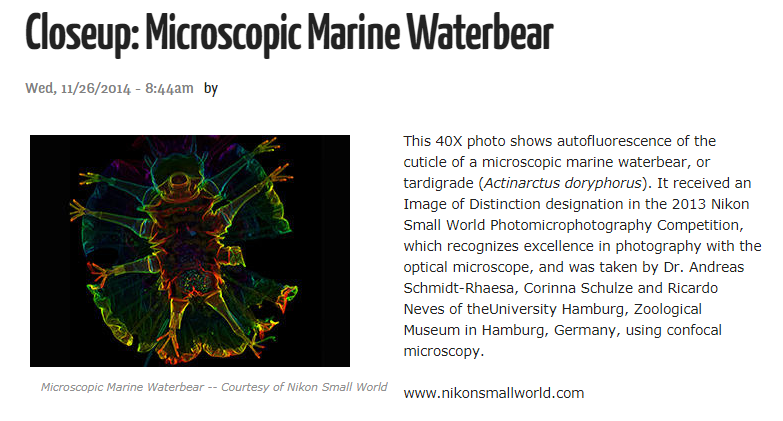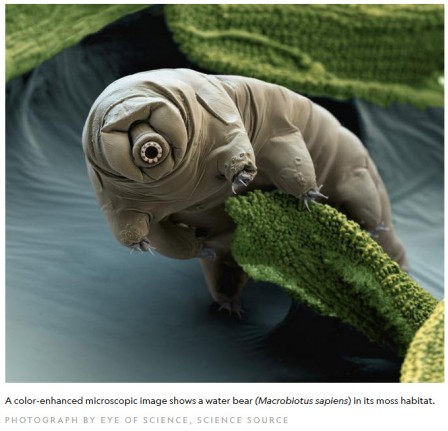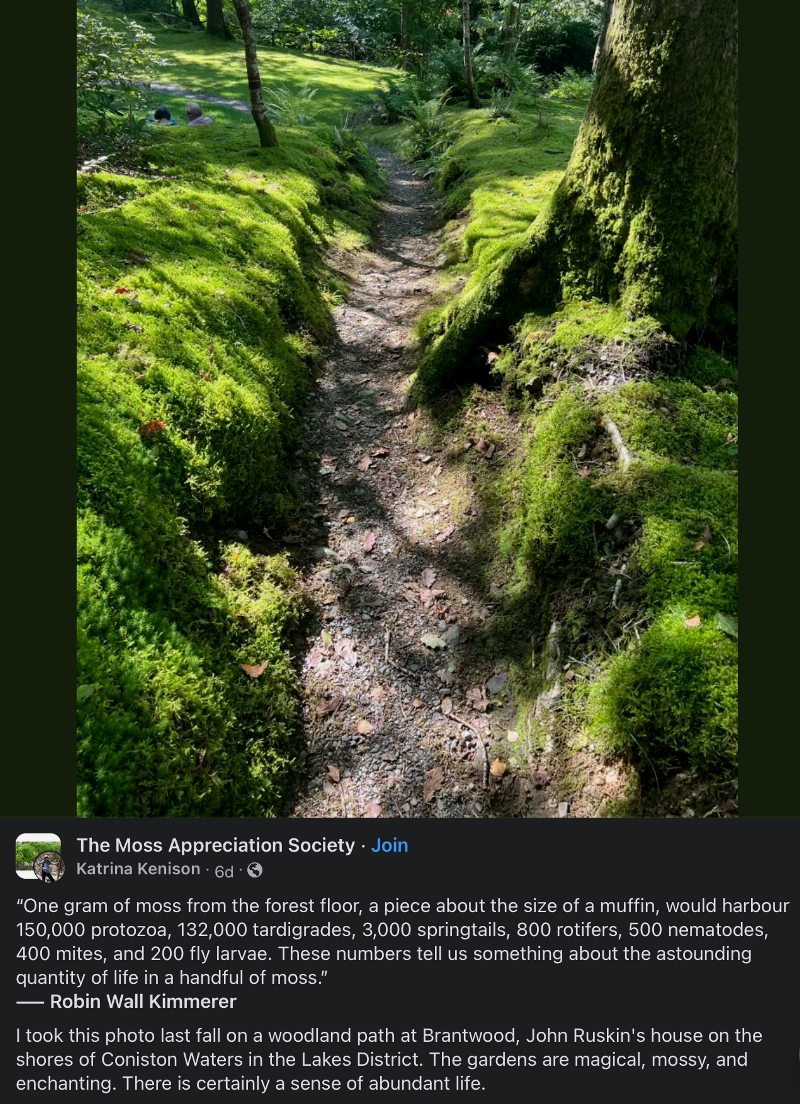File:Tardi1.jpg: Difference between revisions
Siterunner (talk | contribs) No edit summary |
Siterunner (talk | contribs) No edit summary |
||
| (11 intermediate revisions by the same user not shown) | |||
| Line 1: | Line 1: | ||
'''Waterbears''': We | '''Waterbears''': We call them "tiny little ones" at GreenPolicy360 | ||
* https://www.nature.com/articles/s41598-017-05796-x | * https://www.nature.com/articles/s41598-017-05796-x | ||
| Line 10: | Line 10: | ||
<big>'''Microscopic Tardigrade 'Bears' Are Tough'''</big> | <big>'''Microscopic Tardigrade 'Bears' Are Tough'''</big> | ||
'''''Boil them, deep-freeze them, crush them, dry them out | '''''Tardi species are a story of life persevering against the odds''''' | ||
:'''''Boil them, deep-freeze them, crush them, dry them out, launch them into space: tardigrades will survive and come back for more''''' | |||
[[File:Waterbear-2014.png]] | [[File:Waterbear-2014.png]] | ||
| Line 36: | Line 36: | ||
''Tardigrades belong to an 'elite' category of animals known as '''extremophiles''', or critters that can survive environments that most others can't. For instance, tardigrades can go up to 30 years without food or water. They can also live at temperatures as cold as absolute zero or above boiling, at pressures six times that of the ocean’s deepest trenches, and in the vacuum of space.'' | |||
''Tardigrades belong to an elite category of animals known as extremophiles, or critters that can survive environments that most others can't. For instance, tardigrades can go up to 30 years without food or water. They can also live at temperatures as cold as absolute zero or above boiling, at pressures six times that of the ocean’s deepest trenches, and in the vacuum of space.'' | |||
''Their resiliency is in part due to a unique protein in their bodies called Dsup—short for "damage suppressor"—that protects their DNA from being harmed by things like ionizing radiation, which is present in soil, water, and vegetation.'' | ''Their resiliency is in part due to a unique protein in their bodies called Dsup—short for "damage suppressor"—that protects their DNA from being harmed by things like ionizing radiation, which is present in soil, water, and vegetation.'' | ||
| Line 46: | Line 44: | ||
························ | |||
| Line 102: | Line 100: | ||
''Dr. Alan Grant : The world has just changed so radically, and we're all running to catch up. I don't want to jump to any conclusions, but look... Dinosaurs and man, two species separated by 65 million years of evolution have just been suddenly thrown back into the mix together. How can we possibly have the slightest idea what to expect? | ''Dr. Alan Grant : The world has just changed so radically, and we're all running to catch up. I don't want to jump to any conclusions, but look... Dinosaurs and man, two species separated by 65 million years of evolution have just been suddenly thrown back into the mix together. How can we possibly have the slightest idea what to expect? | ||
··························· | |||
'''Time for a walk''' | |||
: On the wild side | |||
| Line 120: | Line 118: | ||
[[Category:Anthropocene]] | |||
[[Category:Biodiversity]] | [[Category:Biodiversity]] | ||
[[Category:Forests]] | |||
[[Category:Green Graphics]] | [[Category:Green Graphics]] | ||
[[Category:Media]] | |||
[[Category:Microbiology]] | |||
[[Category:Microorganism]] | [[Category:Microorganism]] | ||
[[Category:Nature]] | |||
[[Category:Planet Citizens, Planet Scientists]] | |||
[[Category:Sustainability]] | [[Category:Sustainability]] | ||
[[Category:Water]] | |||
[[Category:Wetlands]] | |||
[[Category:Wildlife]] | |||
Latest revision as of 06:15, 12 April 2023
Waterbears: We call them "tiny little ones" at GreenPolicy360
Microscopic Tardigrade 'Bears' Are Tough
Tardi species are a story of life persevering against the odds
- Boil them, deep-freeze them, crush them, dry them out, launch them into space: tardigrades will survive and come back for more
What is a tardigrade?
Tardigrades are microscopic eight-legged animals that have been to outer space and would likely survive the apocalypse. Bonus: They look like adorable miniature bears.
Around 1,300 species of tardigrades are found worldwide. Considered aquatic because they require a thin layer of water around their bodies to prevent dehydration, they’ve also been observed in all kinds of environments, from the deep sea to sand dunes. Freshwater mosses and lichens are their preferred habitat, hence their nickname, moss piglet.
Despite looking squishy, tardigrades are covered in a tough cuticle, similar to the exoskeletons of grasshoppers, praying mantises, and other insects to which they are related. Like those insects, tardigrades have to shed their cuticles in order to grow. They have four to six claws on each foot, which helps them cling to plant matter, and a specialized mouthpart called a bucco pharyngeal apparatus, which allows them to suck nutrients from plants and microorganisms.
Tardigrades belong to an 'elite' category of animals known as extremophiles, or critters that can survive environments that most others can't. For instance, tardigrades can go up to 30 years without food or water. They can also live at temperatures as cold as absolute zero or above boiling, at pressures six times that of the ocean’s deepest trenches, and in the vacuum of space.
Their resiliency is in part due to a unique protein in their bodies called Dsup—short for "damage suppressor"—that protects their DNA from being harmed by things like ionizing radiation, which is present in soil, water, and vegetation.
Another amazing survival trick is cryptobiosis, a state of inactivity triggered by a dry environment. The micro-animals squeeze all the water out of their bodies, retract their heads and limbs, roll up into a little ball, and become dormant. When conditions improve, they unfurl themselves and go about their business...
························
There it is...
Dr. Ian Malcolm : John, the kind of control you're attempting simply is... it's not possible. If there is one thing the history of evolution has taught us it's that life will not be contained. Life breaks free, it expands to new territories and crashes through barriers, painfully, maybe even dangerously, but, uh... well, there it is.
John Hammond : [sardonically] There it is.
Science, chaos, control... Michael Crichton's mind at work
Just because you can, doesn't mean you should...
"Your scientists were so preoccupied with whether or not they could that they didn’t stop to think if they should.”
Dr. Ian Malcolm : If I may... Um, I'll tell you the problem with the scientific power that you're using here, it didn't require any discipline to attain it. You read what others had done and you took the next step. You didn't earn the knowledge for yourselves, so you don't take any responsibility for it. You stood on the shoulders of geniuses to accomplish something as fast as you could, and before you even knew what you had, you patented it, and packaged it, and slapped it on a plastic lunchbox, and now
[bangs on the table]
Dr. Ian Malcolm : you're selling it, you wanna sell it. Well...
John Hammond : I don't think you're giving us our due credit. Our scientists have done things which nobody's ever done before...
Dr. Ian Malcolm : Yeah, yeah, but your scientists were so preoccupied with whether or not they could that they didn't stop to think if they should.
John Hammond : Condors. Condors are on the verge of extinction...
Dr. Ian Malcolm : [shaking his head] No...
John Hammond : If I was to create a flock of condors on this island, you wouldn't have anything to say.
Dr. Ian Malcolm : No, hold on. This isn't some species that was obliterated by deforestation, or the building of a dam. Dinosaurs had their shot, and nature selected them for extinction.
John Hammond : I simply don't understand this Luddite attitude, especially from a scientist. I mean, how can we stand in the light of discovery, and not act?
Dr. Ian Malcolm : What's so great about discovery? It's a violent, penetrative act that scars what it explores. What you call discovery, I call the rape of the natural world.
Dr. Ellie Sattler : Well, the question is, how can you know anything about an extinct ecosystem? And therefore, how could you ever assume that you can control it? I mean, you have plants in this building that are poisonous, you picked them because they look good, but these are aggressive living things that have no idea what century they're in, and they'll defend themselves, violently if necessary.
John Hammond : Dr. Grant, if there's one person here who could appreciate what I'm trying to do...
Dr. Alan Grant : The world has just changed so radically, and we're all running to catch up. I don't want to jump to any conclusions, but look... Dinosaurs and man, two species separated by 65 million years of evolution have just been suddenly thrown back into the mix together. How can we possibly have the slightest idea what to expect?
···························
Time for a walk
- On the wild side
~
File history
Click on a date/time to view the file as it appeared at that time.
| Date/Time | Thumbnail | Dimensions | User | Comment | |
|---|---|---|---|---|---|
| current | 17:18, 14 July 2017 |  | 470 × 264 (28 KB) | Siterunner (talk | contribs) |
You cannot overwrite this file.
File usage
The following 4 pages use this file:


